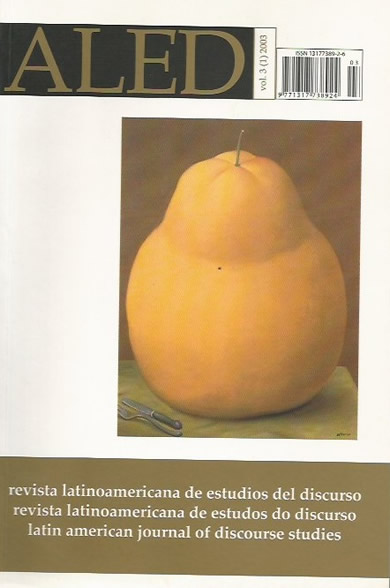Discurso y cognición social en la “red” de las metáforas
Keywords:
metaphor. discourse and social cognition.Abstract
The aim of this paper, which is situated in the interface between discourse and social cognition, is to discuss some aspects of metaphor found in Mexican and Brazilian teenagers’ discourses. A critical and systematic investigation of specific expressions, present in the variants of Mexican Spanish and Brazilian Portuguese, enables us to search for empirical contrasts and profound explanations to the cognitive phenomenon that occurs in language. In the underlying theoretical basis of this work, metaphor is considered as a central element in structuring the discourse. The corpus for this study consists of interviews with Mexican and Brazilian teenagers as well as extracts from local newspapers. The first results point to differences that can be explained by means of social cognition, as suggested by van Dijk. On the other hand, as Fairclough points out, metaphors not only structure the way we think and act, but also have a consistent and fundamental effect on our knowledge systems and beliefs.
Downloads
References
CHOULIARAKI, L. & FAIRCLOUGH, N. (1999). Discourse in late modernity. Edinburgh: Edinburgh University Press.
GARCÃA, O.M. Comunicação em prosa moderna, 13ª ed. rev. e at. (1986). Rio deJaneiro: Ed. da Fundação Getúlio Vargas.
LAKOFF, G. & JOHNSON, M.. (1985). Metáforas de la vida cotidana. Cátedra: Teorema.
FAIRCLOUGH, N. (2001). Discurso e mudança social. Coord. trad. I. Magalhães. Brasília: Ed. Universidade de Brasília.
FAIRCLOUGH, N. (1995). Critical discourse analysis: the critical study of language.London and New York: Longman.
FAUCONNIER, G. Mental Spaces. (1985). Cambridge, London: MIT.
HALLIDAY, M. Explorations in the function of language.(1973). London: Edward Arnold.
HALLIDAY, M. (1975). Estructura y función del lenguaje. EnJ. Lyons (ed.). Nuevoshorizontes en la linguística, ed. cast.pp.145-173. Madrid: Alianza.
HALLIDAY, M. (1994). AnIntroduction to Functional Grammar, 2ª ed. London, NewYork: Arnold.
MARCUSCHI, L.A. (2003). Atividades de referenciação no processo de produção textual e o ensino de língua. En D.E.G. da Silva et alii(orgs.). Estudos de linguagem: inter-relações e perspectivas, pp. 11-42.Campo Grande, MS: Ed. Da UFMS.
REDDY, M.J. (1979). The conduit metaphor ”“ a case of frame conflict in ourlanguage about language. En A. Ortoni (org.). Metaphor and thought, pp.261-296. New York, Cambridge University Press.
SILVA, D.E.G. (1996) La oralidad en el discurso narrativo escrito de adolescentes: elfenómeno linguístico de la repetición. Tesis de Doctorado en Linguística Hispánica, México: Universidad Nacional Autónoma de México (UNAM),195 pp.
SILVA, D.E.G. (2001). A repetição em narrativas de adolescentes: do oral ao escrito.Brasília: Ed. da Universidade de Brasília: Plano Editora: Oficina Editorial doIL- UnB.
SILVA, D.E.G. & Vieira, J. A. (orgs.). (2002). Análise do Discurso: percursos teóricos e metodológicos. Brasília: Plano Editora: Oficina Editorial do IL-UnB.
SILVA, D.E.G., Lara, G.M.P. & Menegazzo, M.A. (orgs.). (2003). Estudos de linguagem: inter-relações e perspectivas. Campo Grande, MS:Ed. da UFMS.
THOMPSON, J.B. (1995). Ideologia e cultura moderna: teoria social crítica na era dos meios de comunicação de massa. Petrópolis, RJ: Vozes.
VAN DIJK, T. (1990). La noticia como discurso: comprensión, estructura y producción dela información. Trad. G. Gal. Barcelona: Paidós.
Downloads
Published
How to Cite
Issue
Section
License

This work is licensed under a Creative Commons Attribution-NonCommercial-NoDerivatives 4.0 International License.
The authors retain the copyright and guarantee RALED the right to be the first publication of the work as well as a Creative Commons Attribution License that allows others to share the work with recognition of authorship and the initial publication in this journal.




